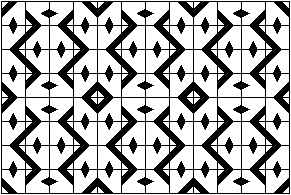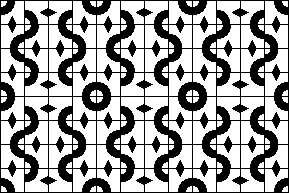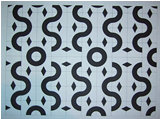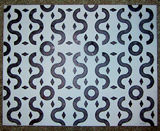

Project #2: Pattern
Objective
1) Create a simple non-symmetrical design on a 1" x 1" square.
2) Combine the square with 3 similar squares (rotated or reflected versions of the original square) to form a larger figure. This figure, too, should not be symmetrical.
3) Assemble these figures in a regular fashion to create a pattern capable of endless repetition. You may use translation, mirror symmetry, glide symmetry, or two-oint or four-point rotation.
Attempt to create unanticipated results, i.e., secondary patterns, the "disappearance" of the initial pattern, the "disappearance" of the dividing lines.
Design Process
I wanted to create a very simple pattern that creates unexpected, visually pleasing secondary figures. One piece of advice I received was to divide each side of the initial square into 3 parts and to align the pattern with these divisions .
| I started with the following pattern | I assemebled it into the following figure by rotation. |
 |
 |
I applied the following patterns to this figure: translation, reflection and translation, reflection + reflection, rotation (2) + reflection, rotation (4) + translation. I felt that the reflection + reflection yielded intersting results:

I liked the creation of secondary patterns, but I felt that the overall composition lacks harmony. It is a bit nervous and edgy. To correct this, I decided to modify the original pattern to be more rounded:
 |
 |
The result after reflection + reflection:

Implementation
 |
I printed the sheet with PowerPoint and hand-copied it onto vellum. Luckily, I found a marker who has a tip who is equal in width to my design! |
Result
 |
Tracing the design on vellum was a lot of work, but I am happy with the result. The new pattern is more pleasing than the original and I like the secondary pattern. It looks like funky people. |